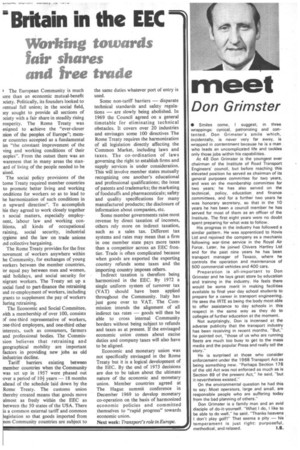Working towards
Page 39

If you've noticed an error in this article please click here to report it so we can fix it.
fair shares el free trade
I The European Community is much lore than an economic mutual-benefit Kiety. Politically, its founders looked to ientual full union; in the social field, ley sought to provide all sections of 3ciety with a fair share in steadily rising rosperity. The Rome Treaty was esigned to achieve the "ever-closer nion of the peoples of Europe"; memer countries accepted as a fundamental irn "the constant improvement of the ving and working conditions of their eoples". From the outset there was an wareness that in many areas the startard of living of the people needed to be aised.
The social policy provisions of the tome Treaty required member countries to promote better living and working onditions for workers so as to lead to he harmonization of such conditions in n upward direction". To accomplish his they agreed to work closely together social matters, especially employtent, labour law and working coniitions, all kinds of occupational raining, social security, industrial tygiene and the law on trade unions Lnd collective bargaining.
The Rome Treaty provides for the free novement of workers anywhere within he Community, for exchanges of young vorkers between the member countries, Or equal pay between men and women, aid holidays, and social security for nigrant workers. The Treaty set up a ■ ocial fund to part-finance the retraining ind re-employment of workers, including ;rants to supplement the pay of workers luring retraining.
The Economic and Social Committee, with a membership of over 100, consists 3f one-third representative of workers, 3ne-third employers, and one-third other interests, such as consumers, farmers and professional bodies. The Commission believes that retraining and geographical mobility are important factors in providing new jobs as old industries decline.
Tariff barriers existing between member countries when the Community was set up in 1957 were phased out over a period of 10+ years — 18 months ahead of the schedule laid down by the Rome Treaty. The customs union thereby created means that goods move almost as freely within the EEC as between the 50 states of the USA. There is a common external tariff and common legislation so that goods imported from non-Community countries are subject to the same duties whatever port of entry is used.
Some non-tariff barriers — disparate technical standards and safety regulations — are slowly being abolished. In 1969 the Council agreed on a general timetable for eliminating technical obstacles. It covers over 20 industries and envisages some 100 directives The Rome Treaty requires the harmonization of all legislation directly affecting the Common Market, including laws and taxes. The co-ordination of laws governing the right to establish firms and supply services is under consideration. This will involve member states mutually recognizing one another's educational and professional qualifications; the issue of patents and trademarks; the marketing of foodstuffs and pharmaceuticals; safety and quality specifications for many manufactured products; the disclosure of information about companies, etc.
Some member governments raise most revenue by direct taxation of incomes, others rely more on indirect taxation, such as a sales tax. Different tax systems and rates may mean that a firm in one member state pays more taxes than a competitor across an EEC fron, tier. Trade is often complicated because when goods are exported the exporting country refunds some taxes and the importing country imposes others.
Indirect taxation is therefore being harmonized in the EEC. By 1972 a single uniform system of turnover tax (VAT) should have been applied throughout the Community. Italy has just gone over to VAT. The Commission intends the alignment of all indirect tax rates — goods will then be able to cross internal Community borders without being subject to refunds and taxes as at present. If the envisaged economic union comes about excise duties and company taxes will also have to be aligned.
Economic and monetary union was not specifically envisaged in the Rome Treaty but it is a logical development of the EEC. By the end of 19'73 decisions are due to be taken about the ultimate nature of the economic and monetary union. Member countries agreed at The Hague summit conference in December 1969 to develop monetary co-operation on the basis of harmonized economic policies and committed themselves to "rapid progress" towards economic union.
Next week: Transport's role in Europe.




















































































































